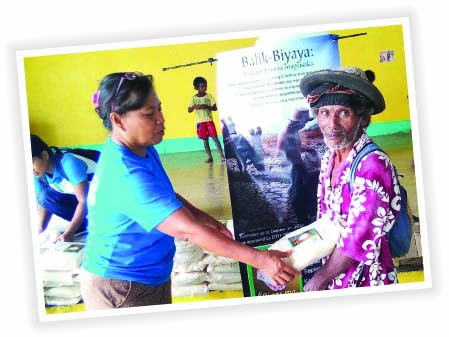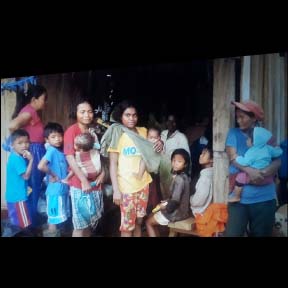
Super typhoon Lawin’s (international name Haima) massive 800-kilometer diameter brought heavy rains, flooding and destruction before making landfall in Peñablanca, Cagayan on the night of Oct. 19, 2016. It left many communities struggling for assistance in its wake.
Signal No. 5, the strongest tropical storm cyclone signal, was raised in Cagayan and Isabela; while Signal No. 4 was raised in Kalinga, Apayao, Northern Abra and Ilocos Norte, Ifugao and Calayan Group of Islands.
In the Cordillera Administrative Region, typhoon Lawin killed 14 people, and damages reached up to P4 billion, according to the National Disaster Risk Reduction and Management Council data. Less accessible places like Baggao in Cagayan only saw trickles of relief – but the trickles were like manna from heaven. This was especially so for nomadic tribes like the Agta of Cagayan.
So, it was such a blessing when they received much-needed relief from the Balik Biyaya project of SL Agritech Corporation. The smile on the faces of children as they received the packs of rice was so heartbreakingly joyful. Balik Biyaya was initially a project of SLAC as their way of giving back to the farmers who were deeply affected by the El Niño phenomenon last year, where about 42 percent of the Philippines experienced drought or dry spells and 39 provinces, cities, municipalities and villages were declared under states of calamity. The worst affected areas were in the Mindanao and Visayas regions.
Launched in October 2016, their first distribution was to 600 farmers in Cotabato. The program had set a goal of raising an initial 20,000 sacks of rice, each sack weighing 25 kgs, to distribute to farmers and fisherfolk. So far, 72,100 kilos of rice have been distributed to 29,000 farmers and fishermen and 7,000 families in Isabela province. The next planned leg of the Balik Biyaya project will be conducted in selected areas in the Visayas.
SLAC’s Balik Biyaya program aims to help farmers and fishermen – the people who produce and help feed the nation through their hard labor and efforts. Through their labor, rice is produced, fish and other edible aquatic products are made available to the market. It is ironic that the ones planting and harvesting rice are the ones who are the most hungry and among the poorest in the Philippines.
Under the program, for every purchase of Doña Maria or Willy Farms rice variety at participating supermarkets, SLAC will give away a corresponding amount of rice: 400 grams for every 2 kilograms, 1 kg for every 5 kgs and 2 kgs for every 10 kgs purchased. The aim is to gather the consumer’s active participation to the program, as well as educate and inform consumers to consciously value and appreciate the hard work of our farmers.
SLAC is the country’s biggest hybrid rice seeds producer. It is a private company engaged in the research, development, production and distribution of hybrid rice seed and premium quality rice. Its chairman, Henry Lim Bon Liong, actively spearheads their outreach program. Another pet project is the Rice Bucket Challenge which he started in September 2014.
For the operation in Cagayan, SLAC gave Kaisa Para Sa Kaunlaran 800 packs of rice weighing 2 kgs each to give to the typhoon victims there. In turn, Kaisa partnered with Cagayan Valley Disaster Response Center through its consultant, Dr. Raul Ting, to facilitate the distribution. The rice packs were dropped off at the Ting-owned Deltra Bus Company in Quezon City where a bus travels to Tuguegarao daily. The trip takes around 10-12 hours one way. The rice was then stored at their place in Tuguegarao. CVDRC volunteers then transported the rice to the various barangays in the Baggao and Aggay areas. The logistical support was done pro bono by the good doctor.
Doc Raul, as he is fondly called, would also use his van and act as driver to bring relief goods to communities whenever he can. Although saddled with a bad back that hampers movement, he has steadfastly served as conduit to various organizations and individuals to bring relief goods to where they are really needed. A medical doctor by profession, he is now more actively involved in their family businesses in Cagayan. When ask to describe himself and his work, he simply replied: a disaster relief volunteer, a humanitarian worker.
He shared a story about an 11-year-old school girl in Cagurungan who died when their house collapsed on her. The family was already in the evacuation center but she had insisted on going back to get her assignment. A cousin had accompanied her back and recounted how a strong wind blew the house away just as the girl entered the house. The girl’s grave is along the path that Doc Raul and volunteers trek to the distribution site. There was a simple cross with a small plastic of food on top.
CVDRC volunteers distributed Balik Biyaya rice packages among families in Lawin-affected areas like Baggao and several indigenous people communities. These IP communities are in hard-to-reach areas and are often ignored. Among the recipients of Balik Biyaya are 141 families in Sitio Cagurungan in Awalan, given last Dec. 4, and 325 families in Barangay Bunugan, a farming community. Another sitio in Mammit received 200 rice packs on Dec. 7. These three areas are in Baggao. The towns of Alcala and Sta. Ana also received Doña Maria rice donated by SLAC. On Dec. 19, 109 Aggay families from Binubongan, Catammugan and Iringan received rice packs. The relief operation was done in Allacapan. Additionally, 25 rice packs were distributed in Nangaromoan on Dec. 9.
All this was done through Kaisa’s linking up with the donor and volunteer workers on the ground. With these linkages, we can do and create more opportunities to help far flung communities. We are creating an invisible channel that allows us to reach out and help and share. Even if we are only few, and hampered by physical and other limitations, what is important is that we continue to do good deeds with good intentions.





